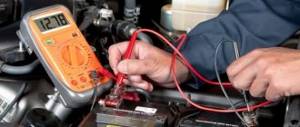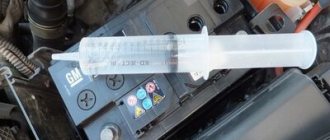Replacing the battery is a very simple operation that any car owner can perform independently. The main problem is when to change the car battery. If the performance of many machine parts can be determined visually, it is almost impossible to understand whether the battery has served its full life in this way.
In a situation where the battery is not able to start the engine, there is also a lot of uncertainty, because from time to time the battery may be completely discharged, but this condition is absolutely normal and can be easily eliminated by connecting the battery to a charger. Next, we will consider the main signs by which one can judge that it is time to change the car battery.
When is the best time to change the battery?
If it is known that the battery life is coming to an end, but the battery is still capable of starting the car engine, then it is recommended to replace it in the autumn season. At sub-zero temperatures, significantly more energy is required to start the engine, so a product that can easily cope with such an operation in the summer can fail at any time when cold days arrive.
In addition, the car owner may be unpleasantly surprised when he finds the car battery completely frozen. If the battery is used for many years, then as a result of the formation of a large amount of plaque on the plates, which does not pass back into the electrolyte solution, its density noticeably decreases.
As a result, the freezing point of such a liquid decreases, which leads to the formation of ice inside the battery case. Freezing of the electrolyte, in many cases, leads to destruction of the plates, which makes further operation of the battery impossible.
In addition to the above reasons for replacing the battery in the fall, one can mention significantly higher energy consumption in winter. First of all, the load on the battery increases due to the need to frequently turn on lighting devices due to short daylight hours. This problem is especially acute in northern latitudes, where a day in winter can last only a few hours.
The second reason is the slow movement of vehicles on icy roads. The need to be careful does not allow driving at significant engine speeds, therefore, in this mode of engine operation, the generator can be automatically turned off, as a result of which the main burden of providing electricity to all consumers will fall on the shoulders of the battery.
Electrolyte and its role in a car battery
Passenger cars equipped with internal combustion engines use lead-acid batteries. The battery plates are in a special liquid that can conduct electric current - electrolyte. Battery electrolyte is a solution of hydrochloric acid in distilled water.
Foreign impurities in the electrolyte are not allowed, since they worsen the characteristics of the liquid - density and electrical conductivity.
A lead-acid battery uses three components to carry out current-generating processes:
- lead dioxide PbO2 located on the positive contact (cathode);
- spongy pure lead present on the negative terminal (anode);
- electrolyte.
As the battery discharges, pure lead at the anode is converted into PbSO4 sulfate. In this case, the substance changes color and gives up two electrons to the electrical circuit. At the cathode, electrons are absorbed and lead dioxide is converted to sulfate. The movement of electrons is carried out through an external circuit.
The design and principle of operation of a lead-acid battery
When lead sulfate is formed at the cathode, sulfuric acid is consumed from the electrolyte solution, which leads to a decrease in density. If the battery is charged, then the processes go in the opposite direction. Recharging continues until a certain point, after which the density of the solution does not increase further. This moment is considered the point at which the battery is fully charged. Further charging leads to the decomposition of water into oxygen and hydrogen, which are released from the electrolyte in the form of gas bubbles. This process is called battery boiling.
Signs of battery wear
The main sign by which one can judge that the battery is severely worn out is the rapid discharge of the battery. If you have to frequently charge the battery, and the generator and electronic regulator of the car are in good condition, then the battery will need to be replaced in the very near future.
Rapid boiling of the electrolyte is also a sign of imminent battery death. Deposition of sulfates on the plates leads to a significant decrease in battery capacity, which causes excessive formation of gases inside the cans, even when standard charging current is applied to the terminals.
A decrease in discharge current indicates that the internal resistance of the battery has increased significantly. If this indicator increases significantly, the battery will completely lose the ability to start the engine, so at the first sign of such a malfunction you should try to restore the battery charge using a charger. You can more accurately determine the internal resistance of the battery as well as its discharge current using special instruments.
How to measure battery voltage correctly
The most accurate values can be obtained by performing a set of diagnostics. To do this, you need to have special devices with you (multimeter, voltmeter or load plug). To measure voltage from the battery, it is necessary to connect the contacts of the device and the battery terminals.
During diagnostic procedures, it is worth understanding that the power source connected to the vehicle’s on-board system consumes energy. Therefore, the readings may be slightly lower, but they should not fall below 11-11.5 volts. Carrying out correct measurements is permissible on a completely disconnected and charged battery, that is, the electrical circuit must be open. However, this is an optional condition: if you check the voltage in a closed circuit, then take into account a certain error.
- The battery is connected to the system of a car that is not started. Under this condition, the on-board network consumes a certain amount of energy, so the voltage indicator should be in the range of 12.5-13.0 V.
- With the car running and the energy consumption sources turned off, the device readings should vary between 13.5 and 14 volts. Higher readings indicate that the battery is discharged and the generator is not operating normally. It is worth considering that an increase in data in the cold season is not an accurate indication of a low battery. If the voltage is within limits for some time, then the system is fully operational. Reduced readings (from 13 to 13.4 volts) indicate some discharge of the battery. Battery needs charging.
- With the car running and power consumption sources turned on, the voltage value should be greater than 12.8-13.0 V.
Please note that working with a multimeter or voltmeter allows for an inverse relationship between the poles of the measuring device and the battery terminals. The load plug must be used strictly in accordance with the polarity
We do not recommend checking your car's battery voltage using the on-board system because it is not directly connected to the battery. Therefore, certain measurement errors are allowed.
Checking the battery charge by voltage is recommended some time after the car battery is fully charged, as well as at operating temperature (about 20 degrees Celsius).
Below is the table “Battery charge level by voltage”.
Battery charge level
Open circuit voltage of low-antimony (Sb/Sb) and hybrid (Sb/Ca) batteries, volts
Open circuit voltage
in calcium (Ca/Ca) and AGM/Gel (Ca/Ca) batteries, volts
How often should you change your car battery?
Battery life depends on many factors. First of all, the battery life is affected by manufacturing technology. For example, modern maintenance-free products can last approximately 2 times longer than conventional antimony batteries. In addition, the frequency of battery replacement is affected by operating conditions and compliance with the rules for using such a product as a starter device.
The average predicted service life of batteries of various designs is:
- For low-antimony batteries – 4 years.
- For calcium batteries – 5 years.
- Maintenance-free calcium batteries – 6 years.
- AGM – 10 years.
- EFB – 7 years.
- Gel – 10 years.
The service life of the battery is also affected by the duration of storage before sale. To find out the production time of the product, just find the code on the cover, which is not difficult to understand whether you can purchase the battery or whether it is better to refuse the purchase.
How often do you change the battery?
It is interesting to know how often batteries in cars need to be changed and what determines the interval set by the manufacturer.
A normal indicator is usually 5-6 years of operation. That is, this is quite a good period for any battery.
At the same time, you can still find cars that have batteries under the hood that were installed 8-10 years ago. It is also interesting that these are mostly cars that came to us from Europe. Several explanations can be given here:
- Automobile manufacturers use standard batteries from trusted manufacturers. That is, these are really good quality batteries.
- Operating conditions relevant for European countries differ markedly from Russian ones. This is a milder climate, high-quality roads.
If the climate in the country is warm, that is, the battery is not affected by one of the main negative factors in the form of extreme cold, then the battery will need to be changed literally every 8 years.
This does not apply to Scandinavian countries, where temperatures often drop below -10-15 degrees Celsius. And the recommended replacement interval from the manufacturer is 5 years.
If we talk about when it is necessary to change the old battery under the hood of a car in Russian conditions, then the situation is somewhat different.
The norm is considered to be an operational life of about 6-7 years. For a number of commercial vehicles the standard is 7 years.
But such standards do not allow us to accurately answer the question of how long it will take to change the old battery on a particular car. The frequency is influenced by a number of factors. And in some cases, the battery life ends much faster than the manufacturer indicated on the packaging.
To understand how often you actually need to change a worn-out car battery, you need to start not from the stated period, but from what factors affect battery wear. When exposed to them, the battery life is reduced, and the first characteristic signs of wear begin to appear.
Is it worth waiting until the last minute to replace the battery?
Buying a battery is quite expensive for the car owner, so almost all motorists strive to completely exhaust the battery life before replacing it. This should not be done for the following reasons:
- Reduced operating safety of the machine.
- Risk of electrical equipment failure.
- Increased engine wear during startup.
A stingy person, as we know, pays twice, but failure to replace the battery in a timely manner can lead to an accident that can cost life or limb. For example, if a car suddenly stalls at a busy intersection or railroad crossing, a worn-out battery may not be able to quickly start the engine.
A “half-dead” battery negatively affects the performance of electricity consumers. In addition, it will take much longer to start the engine. Numerous attempts to start the car at low crankshaft speeds cause increased wear of internal parts due to oil starvation, as well as grinding of the starter gears and engine flywheel due to poor engagement.
Considering the negative impact of an inoperative battery on the comfort and safety of using the machine, it is recommended to promptly replace the machine’s battery with a new product.
How can you determine when it’s time to change the battery in your car?
Each car part has its own resource. This also applies to the battery. Over the years of operation, the battery loses its characteristics, the battery capacity decreases, and it becomes more and more difficult to start the car in winter. However, some drivers may ignore battery problems for a long time until the car stalls on the road or, worse, on the highway. To avoid this situation, you need to monitor the battery life and replace it with a new one. How can you determine when it’s time to change the battery?
- Checking the battery charge
- Fully charge the battery and check
- Checking the battery capacity
- Conclusion
Frequency of replacing the battery in the car
It is believed that the battery should be changed every 3-4 years of operation.
This is how you will feel confident in the winter, you will know that there will be no problems with the ignition, and you will not have to ask your friends to “light a cigarette.” However, it is known that batteries from well-known manufacturers last approximately 4-5 years. You need to remember that the operating conditions of the car may be different, so you shouldn’t rush to the store. It is better to conduct several tests and checks. In addition to the fact that you can diagnose the battery in a specialized service center or yourself using instruments, there are signs by which you can understand that something is wrong with the battery.
What problems does an old battery cause?
- Almost every engine start is difficult, including in warm weather;
- The on-board computer constantly indicates the need to charge the battery;
- There is an unpleasant odor from the battery;
- After an hour of listening to music or with the lights on, the battery dies and cannot start the car.
- After intense and long driving, checking the battery with a voltmeter shows a low battery level;
- Even after a whole night of charging the battery, the electrolyte density does not reach the norm (1.25);
Based on these signs, you can understand that the battery needs, if not replacement, then at least a serious check. A few more signs:
An indication for replacing the battery is a low level of electrolyte density in one of the cans, when in others it is normal or slightly reduced.
If the car is used in a taxi or a minibus, that is, very intensively, the battery is in constant recharge mode and wears out significantly. The service life of such a battery can be only 1-2 years. However, you need to understand that problems with the battery do not always indicate the need to replace it. The battery may not be charged enough.
Checking the battery charge
To check the charge of your car battery, you can use a voltmeter or multimeter. The test is simple, but first disconnect the battery. Measure the voltage at the terminals and evaluate the result. The optimal voltage in the battery is 12.6 V. This means that the battery is fully charged and working properly. A reading of 12.2 V indicates a slight discharge. If the voltage is below 12 V, then the battery should be charged immediately.
Fully charge the battery and check
Before drawing conclusions about the need to replace the battery, you should fully charge it with a special device.
By the way, manufacturers do not recommend using batteries in cold weather if they are charged less than 75%. Before the onset of winter, be sure to fully charge the battery so as not to stall on the road later. If you have fully charged the battery and it cannot start the car engine, then the problem is serious and the battery should be replaced. Unless, of course, the problem with the ignition is something else, for example, the starter has failed.
It happens that the battery is able to start the engine only once or twice in a row, and then the voltage drops significantly at the terminals. This indicates that the battery life is exhausted and you should think about buying a new battery.
If you doubt the quality of the battery, you can always contact a specialist. For example, in stores that sell batteries, you can also find services for checking your battery. It happens that it is not the battery that is to blame, but the generator, which does not provide the necessary charging.
Checking the battery capacity
Battery capacity is a very important indicator that reflects how long the battery can operate without loss of current. Capacity is measured in ampere hours. It can be difficult to do it yourself, so it’s better to contact a service station.
In life, such a test can be the low beam on, which was accidentally left overnight. A good battery should last at least 12 hours.
Conclusion
An old battery that needs replacing can be a headache for any car enthusiast. Difficulty starting the engine in winter is the most common problem. Therefore, you should not hope for chance and wait for the time when you will be late somewhere due to an unreliable battery.
At the same time, a used battery can always be sold to buyers or taken to a store to get a good discount. In this case, a new battery will be cheaper and will not let you down on the road.
Factors or how long does it take to change the standard battery in a car according to science?
Any battery can work without problems for 5-7 years, but only if there are no defects, internal defects and the following conditions are met:
- working relay regulator and generator;
- no increased voltage;
- preventing deep discharge.
These same conditions constitute the energy base, which determines the capacity of the car battery and, of course, its service life. Moreover, experts assure that an increased charge voltage has the most negative effect on the serviceability of the battery - the electrolyte level decreases and water evaporates. This can happen regardless of the time of year, and it is not easy to detect the moment when the voltage in the on-board network has risen to 15 V - a voltmeter is not included in most cars. However, increased voltage can damage the battery within a month.
Deep discharge is extremely dangerous for battery sections that have been in use for more than one year. New products are not afraid of this procedure - additional charging can completely restore the parameters. But be that as it may, preventative recharging, especially in winter during urban travel, is necessary. To ensure that the question of how long it takes to change the battery in a car does not arise before the allotted time, and, therefore, to significantly extend the service life of the battery, it is enough to follow simple rules:
- when starting a cold engine, do not turn on powerful consumers (heated seats and rear window, headlights, etc.), otherwise the battery will not receive the required level of charging;
- use high-quality synthetic motor oil;
- a few minutes after starting the internal combustion engine, start driving in 1st or 2nd gear, this helps to effectively warm up the engine and actively charge the battery.
As the practice of operating passenger cars in central Russia shows, one should prepare to replace the battery after three to four years of regular use. Particularly striking signs indicating the need for this procedure include:
- Presence of sulfuric odor.
- The voltage drop at the battery terminals is below 11V.
- Lack of energy to rotate the starter even for the first 3-5 seconds.
- The drop in electrolyte density in all is below 1.11.
- Self-discharge with an increase in electrolyte density from 1.27 to 1.32 g/cm³.
The most accurate state of the battery is characterized by capacitive parameters. Among experts, it is accepted that 40% of the declared factory figure indicates the need for replacement.
Signs that replacement is needed
Are there specific symptoms that indicate that our “patient” is hopelessly ill and we need to plan a trip to the store soon?
Yes, there are such signs, and they will help you understand that you need to change the battery:
- if difficulties with starting the power unit appear even in the warm season, it means that the battery no longer holds a charge, and if the electrolyte indicators correspond to the norm, this is evidence of the imminent final demise of the power source;
- If, after a long distance trip, as a result of measuring the voltage at the battery terminals, the readings are below normal - the battery is not able to accept a charge from the generator. In normal condition, it should be charged to 80–90% of the rated capacity;
- if, as a result of a full charge that lasted 12–24 hours, the density of the electrolyte could not rise above 1.25 g/cm3, then the battery needs to be changed, even if such a picture is observed only in one bank;
- You can also assess the condition of the battery by the color of the electrolyte: if it is dark and the liquid itself is cloudy, this is a symptom of crumbling plates; batteries with such a defect do not last long;
- The simplest test of battery performance is to turn on the car radio with the engine off for 60 minutes: if after this the engine starts with great difficulty, it means that the battery runs out very quickly, and if the battery is more than 4 years old, you can safely think about purchasing a new battery.
You should not ignore the battery icon lighting up on the dashboard - this indicates problems with charging the power source.











